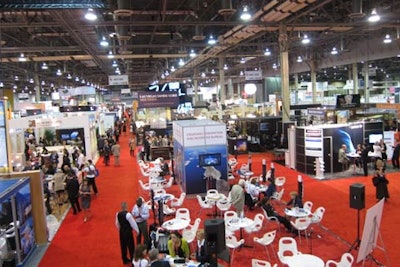
The organizers of IMEX in Frankfurt brought the first IMEX America to the United States this week, sprawling the show over the Sands Expo, amid an atmosphere of optimism and steadily flowing business. (Indeed, the closing press conference revealed 30,000 meetings took place during the show.) The massive exhibition focusing on incentive travel, meetings, and events brought almost 2,000 exhibitors—substantially more than expected—representing 140 global destinations, 2,000 hosted buyers from around the world, and 1,700 non-hosted attendees.
The programming kicked off with "Smart Monday," a full day of professional education, including a speaker lineup from partner Meeting Professionals International, and continued Tuesday through Thursday with nearly 100 educational events. In the classrooms, on the show floor, and in meeting rooms at the Venetian/Palazzo, an array of recurring themes indicated some of the industry’s hot topics. Here are the top five:
1. Hybrid Meetings
Hybrid and virtual meetings were among the show’s most controversial topics, perhaps not unexpected for an industry built on face-to-face interaction. Several industry pros voiced skepticism. “We’ve not found any case examples of people showing a positive return on the hybrid portion of their event,” said Fast Future Research C.E.O. Rohit Talwar. “It always costs them more than they get back, versus live or online meetings, which are still profitable. But there are intermediate steps—for instance, putting video content online or doing a two-hour virtual component. [Otherwise] you end up distorting your event in favor of the virtual audience, and the people who are there live feel they’re not getting as good an experience.”
At a roundtable-style session, participant Tracy Riggan, director of meetings and events for Illinois-based IPC, said she experimented with the hybrid meeting model, and had just one online registrant, whereas the live attendee count was on par with previous years. For her audience at least, hybrid was not the right route.
Virtual Edge Institute executive director Michael Doyle acknowledged that people are wary, but argued that hybrid and virtual meetings can boost face-to-face meetings. “We’re in the very early stages of this. People are still experimenting and there aren’t a tremendous amount of best practices out there, but we are making a lot of progress. It’s getting much safer to do these kinds of digital engagements,” he said.
Doyle said that people are using hybrid and virtual elements to reduce their financial risks: “If you’re unsure about what the economy will look like nine months out or whenever your event is happening, virtual can help mitigate that risk.” It also can compensate for a reduction in travel budgets and increased demands on executives’ time resulting from downsized workplaces. He said one in three corporations is already doing hybrid events.
Doyle also argued that virtual and hybrid meetings can ultimately drive attendance to live events. "When television first came to the sporting industry, it was not well received," he said. "The owners, the people who ran the stadiums, tried to keep [TV] out. They were very afraid that people would not come to the games if they had the option to watch at home. But broadcast actually allowed the industry to mushroom. So 90,000 people go to the physical Super Bowl, but 90 million participate. So that’s the analogy that we’re headed toward with the B-to-B event industry. Once we embrace these extensions, we can drive more attendance.”
2. Sustainability
A variety of sustainability standards now exist and attention to them is gathering steam. "You have to define your objectives from the beginning,” said Tamara Kennedy-Hill, executive director for the Green Meeting Industry Council, in a session that discussed those standards. “And then, of course, we are an industry of relationships. So how are your suppliers performing? What are you asking of them in your RFP? You have to work together to find your goals are realistic and executable. It’s a journey."
In the “Sustainability Center” on the show floor, Meeting Professionals International's manager of corporate social responsibility and sustainable events, Roger Simons, addressed the ways in which sustainability trends are shaping the meeting industry. These include looking at emissions and trying to reduce them, an increased interest and demonstration in responsible business practices overall, and competition among industry players. “As soon as one company addresses it, the rest want to catch up,” he said, citing a study in which 93 percent of C.E.O. respondents across industries think sustainability is critical to the future of their business. Among the reasons they choose to adopt sustainable practices: brand trust and reputation, revenue growth, customer demand, and employee engagement and recruitment
Also at IMEX, American Express Meetings & Events and Maxvantage announced their support for the Carbon Accounting Company’s Green Hotels Global, a program that helps meeting planners, clients, and hotels by providing metrics to help measure carbon footprint, water use, and waste during meetings, and providing ideas to manage environmental goals and cost-saving efforts.
3. Budgets
With significant uncertainty surrounding the economy, the main message was to get creative. “We’re tasked with doing more with less without sacrificing results,” said Kimberly Hardcastle-Geddes, vice president and chief account strategist for San Diego-based Marketing Design Group, who offered a slate of tips for maximizing marketing budgets while thinking differently.
For one thing, she said, “Have a written strategic marketing plan. When you’re making use of a limited budget, it’s absolutely critical that you start out with a sound strategic plan and that you have it in writing and share it with every member in your organization so everyone is focused on working together to achieve the objectives.
"Whatever strategy you employ, make time at the beginning for research, analysis, strategic-planning sessions, et cetera. Do your best to look at everything from a completely fresh perspective, otherwise you fall into the trap of 'because we’ve always done it this way' for your next event."
Paraphrasing Vinnie Polito, chairman of the International Association of Exhibitions and Events, she said, "Think of yourself as the competitor for your own event. What would you do differently?"
Hardcastle-Geddes also emphasized tactics like database scrutiny and analysis, with individualized instead of one-size-fits-all approaches to marketing to those names, tracking and measurement, and strategic partnerships—making the best use of “O.P.M.,” or other people’s money, as she called it.
Importantly, she said event and meeting organizers must “create an experience that exceeds expectations,” which will generate word-of-mouth marketing both on social media and the old-fashioned way, and will contribute to retention of exhibitors and sponsors.
Fast Future Research's Talwar said he expects future cost-control and budgeting strategies to include closing unprofitable meetings, running shorter events, merging events, and choosing cheaper destinations. He also expects more revenue generation through meetings and events in the form of packaging and resale of event content, like video, and demanding greater financial support from host cities and venues. “Look for more and more of that as associations come under cost pressures,” he said.
4. Justifying Meetings' Value
Revent L.L.C.'s Roger Rickard explained that the industry must be better prepared to justify meetings' value, especially in the downturn, and that now there are better tools that can be used to explain economic significance. The facts show that the industry is responsible for 1.7 million direct jobs, a figure derived from a study conducted by PricewaterhouseCoopers on behalf of the Convention Industry Council with an array of industry partner organizations in 2009, when the industry was down. An additional 4.6 million indirect and induced jobs come from meetings. "So really, that's 6.3 million jobs affected by the meetings industry—and that’s in a bad year," Rickard said. According to the United Nations World Tourism Organization's definition of a meeting, there were 1.8 million of them in all—meaning one direct job associated with every one meeting, and three indirect jobs associated with each.
Additionally, meetings contribute to the successes of other businesses, because people are in the town spending money; for that reason, meetings are important to local communities. And meetings help create brands for global destinations. Further, meeting industry taxes bring in $110 billion annually to government coffers.
"As individuals, we must be willing to speak out, and we must demand of our industry leadership that they be willing to speak out," Rickard said regarding the importance of advocacy.
5. The Future of Meetings
Talk about a broad topic. Accordingly, ideas were far-reaching and varied. For starters, look for free or affordable Wi-Fi everywhere in accordance with attendee expectations, along with mobile apps and online conference communities, and an Internet that is even more immersive and interactive, according to Fast Future’s Talwar, who said, “How we bring that into events will be very important. More and more we’ll have tags all over everything, like this glass in front of me. People will have more information, intelligence. You’re seeing the first pieces of that in the event world.”
Describing the increasing high-tech space of conferences and trade shows, he said, “I can see how long people spend at every piece, and then I can offer comparative information to exhibitors. Who spent the most time at your stand, versus [visiting] other people? That will give you real insight to design your trade show presence.” He sees a marketplace in which trade shows will increasingly become “solution fairs” and “learning zones,” with organizers vetting exhibits to make sure there is real innovation available for attendees and participants. He sees immediate implementation of smart, business-generating ideas on shorter planning cycles.
Look for more genuine dialogue between speakers and delegates, and formats that support and encourage participation and social learning during conference sessions. “Participant expectations are rising. People want proof of value, the contacts [they] make, the learning [they] do.”
He added, “It’s a very turbulent decade. So we should build something that can survive the turbulence. Anything better than that is gravy. Every single industry will reinvent its business model in the next 10 years.”



















